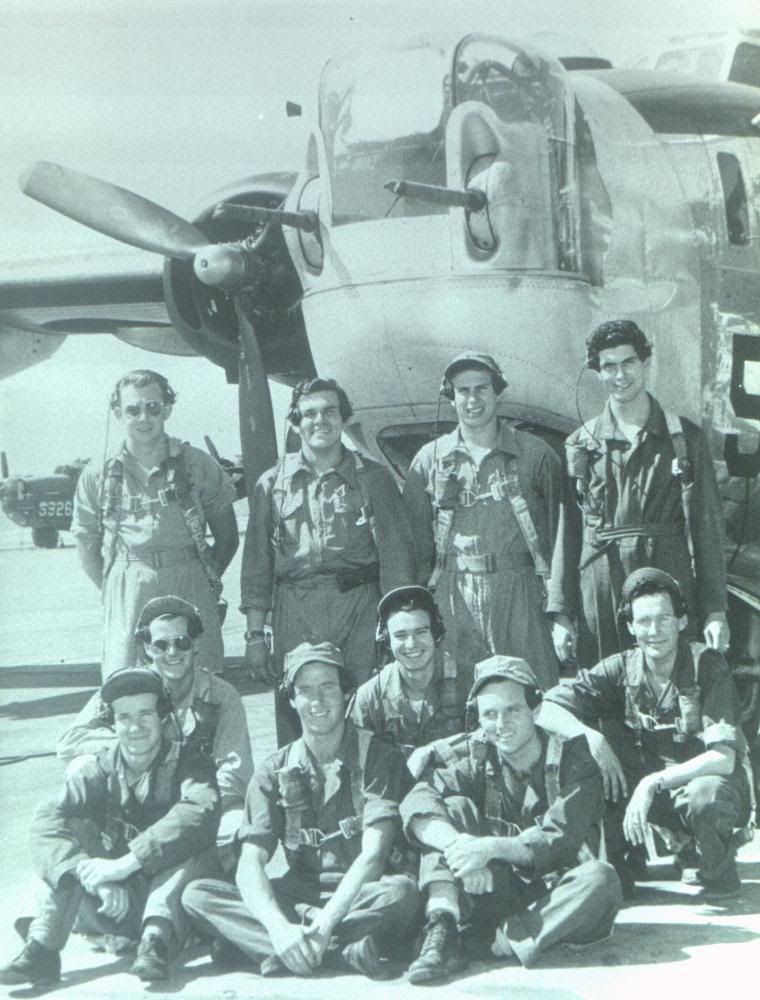I got to thinking about "my" B24 crew this weekend mainly because of the holiday, but the keyboard commandos on both 200 and the BBS also had me thinking about them. They became 'my' crew back in 1991 after a chance meeting with the younger brother of one of them in the bomb bay of a restored B24. He was looking up at the cockpit and was crying. I was there with my son, and asked if he'd been in B24s. He said no, but his brother had been killed in action flying as a co-pilot in a B24. I asked him if he knew anything about what happened. He said no. I offered to see if I could find out and he agreed to let me try. This lead to a 10 year project and friendships with the three surviving crew as well as the families of some of those who were killed. It's my job now to make sure they aren't forgotten.
The picture below was taken while they were in training. Look close at the faces and how young they were. If you want to learn more keep reading after the photo.

There are ten young men in the picture. The youngest was 18, the oldest 32. Most were in their early 20s. They came from all over the US. Minnesota, Wisconsin, Indiana, Illinois, Alabama, Ohio, Pennsylvania, Nebraska. California and Utah. Some were farm kids, others from the city. Five of them had been to college. They were oldest sons, youngest sons and only sons. One came from a broken home and had been raised by an aunt. 3 of them were married. They covered the spectrum in thier politics and their religions. Democrats and Republicans. Catholic, Lutheran, Baptist, Methodist, Morman, Jewish. One believed in nothing at all. One had been a Chicago cop. Another had been a professional dancer.
They all came together to form a bomber crew. And they were very good at it, despite their differences. They were so good at it they ended up as a Pathfinder crew while flying missions with the 15th Air Force in Italy. They had their share of near misses, flak hits, and a forced landing. They were brave, and they were scared. One surviving crew member told me that if they hadn't been shot down, he'd probably have lost his mind. But he kept climbing back into that 24 for the sake of his buddies on the crew.
A flak shell exploded in the cockpit on Valentines Day 1945, killing both pilots instantly. As the 24 fell the others fought to get out. Of the ten in the photo only four survived to become POW's.
I think about how diverse of a crew that was. They represented many parts of the US in where they were from, in their values and in their differences. Their strength was realizing that the sum of their parts made for a good bomber crew. They didn't all have to think alike or agree on everything. That didn't mean they couldn't work together for a common cause.
I think about all the keyboard commandos out there preaching about how bad this is, or how we should not speak on this or that, or how we should all walk the same walk and I wonder if they've forgotten what all those men and women who have given their lives for us, were fighting for.
They weren't fighting to make us all the same, but to protect our right to live, think and believe freely, like all the combat vets out there.
If you've read this far, the crew flew with the 736th BS, 454th BG, 15th AF, based at San Giovanni, Italy. They flew their first mission in October 44 and went down February 14, 1945. They're all gone now as the surviving crew have since passed away. I was honored to be able to call them my friends.
Left to right back row in the photo. Lt. Richard Fry(Pilot), FO Jon Shepard (Bombardier), Lt. Alvin Brody (Co-Pilot), Lt. Bob Slyder (Navigator.
Middle Row: Sgt. Harry Kincaid (Engineer), Sgt Don Bucholtz (Radio), Sgt. Bob Haws (Top-Turret)
Front Row: Sgt. Earle Kulhanek (Waist gunner), Sgt. Ed Stanton (Waist Gunner) Sgt. Russ Mars (Tail Gunner)
They flew a Pathfinder B24 so there was no ball turret as there was a radome in the ball turret opening. Bob Slyder, Bob Haws, Russ Mars and Ed Stanton survived to become POWs. The others were KIA with 5 of them still MIA. One, Harry Kincaid somehow survived the crash but died in a hospital in Czecheslovakia as the war ended.